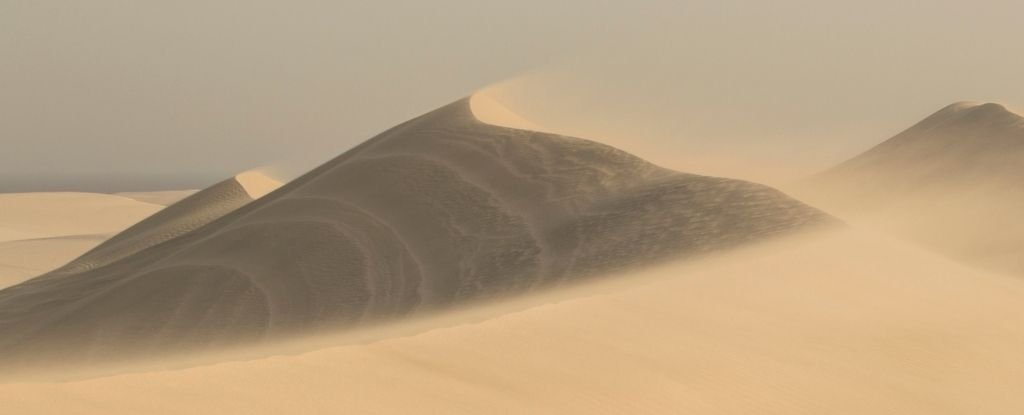Featured
- Get link
- X
- Other Apps
Sand Dunes Breathe? Singing Sand?
Surprising Discovery Reveals Sand Dunes 'Breathe' Water Vapor Science Alert - March 31, 2022

Desert landscapes are not as lifeless as they look. Vast seas of sand dunes can not only grow, move, and interact with one another, a recent study suggests they can also 'breathe'. Using a super-sensitive probe that took decades to invent, researchers have shown sand dunes regularly inhale and exhale tiny amounts of water vapor. The inhales are harder to achieve when the sand is drier. But when the wind flows over the surface of a dune, it carries off the top layer, creating a rapid change in surface moisture and pressure. As a result, "evanescent waves of humidity" from the atmosphere above flow downward. The probe used to detect this flow is so sensitive to moisture, it can pick up tiny films of water on a single grain of sand.
+
Sand Dunes ‘Communicate’ with Each Other
Scientists at the University of Cambridge found that sand dunes could communicate with each other by pushing in opposite directions when exposed to wind or water.
Singing Sand Dunes Explained

Singing Sand Dunes Explained - National Geographic - November 1, 2012
When Marco Polo heard it in China, he suspected evil spirits. When residents of Copiapo, Chile, heard it emanating from a sandy hill, they dubbed the peak El Bramador, for its roars and bellows. Scientists today call it "singing sand," but they're all referring to the same thing: As sand grains shuffle down the slopes of certain sand dunes, they produce a deep, groaning hum that reverberates for miles. But how these dunes produce this "music" remains a much debated mystery. Another vexing question is why different dunes sing different tunes - and how can some even sing more than one note at a time?
A trio of Parisian biophysicists think they know the answer. It's not necessarily the motion of the sandy ocean that determines the pitch of the note - it's the size of the grains, though why the size matters is still unknown.
The researchers first tracked down a pair of singing dunes, one in Morocco, the other in Oman. Working literally by the seat of their pants, they scooted feet-first down the hills to trigger the avalanches. They found that, while the Moroccan hill moaned at a steady 105 - or a low G sharp - the Omani dunes sang a nine-note blare that ranged from 90 to 150 Hz.
With the sounds identified, the team packed their suitcases with 110 pounds (50 kilograms) of Moroccan sand and 220 pounds (100 kilograms) of Omani sand and hauled them back to their lab at Paris Diderot University. "If you want to make it sing, you need a lot," noted study leader Simon Dagois-Bohy.
Making Mini-Avalanches
In the lab, the team recreated the avalanches in miniature, analyzing the speed, depth, and makeup of the cascades. As it turns out, the one-note Moroccan sand grains are almost entirely the same size - 160 millionths of a meter, or microns across- but the noisy Omani sands run the gamut, from 150 to 300 microns.
But when the messy sands were sieved down to just the 200-to-250 micron particles, the tone cleared into a single tone. "The size of the grain controls the actual sound," Dagois-Bohy concluded.
Why exactly this happens, and how the sound itself is created, is still uncertain. However, the Parisian group suspects that, during an avalanche, grains of sand move together down the dune - each grain colliding with and rolling around its neighbors, creating a constant stream of collisions. Larger grains of sand move around each other at slower rates, and vice versa for smaller grains.
Each bump makes a shock that, on its own, would be all but inaudible. But add them together in the right conditions, said study co-author Stephane Douady - and the team is still working out what those precise conditions actually are - and you get the sound of millions of little shocks.

easy, right? click on older posts
Contact Me


indeed!
a good thing...

Popular Posts
OTIS: Hazel's blog on Thread, Fashion and Costume: Mulyana
- Get link
- X
- Other Apps
Santa is a Monk or a Psychedelic Mushroom?
- Get link
- X
- Other Apps





Comments
Post a Comment
send me your idea!